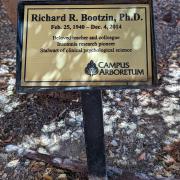Scheduled Tree Tour
Accession Number
11263
Stop Title / Location
Richard R. Bootzin, Ph.D.
Tour Stop Botanical Family
Anacardiaceae
Tour Stop Scientific Name
Pistacia lentiscus
Tour Stop Common Name
Mastic Tree
Sponsored Tree
Richard R. Bootzin, Ph.D.
Feb. 25, 1940 - Dec. 4, 2014.
Beloved teacher and colleague,
Insomnia research pioneer
Stalwart of clinical phycological science

Tour Stop Weight
82

